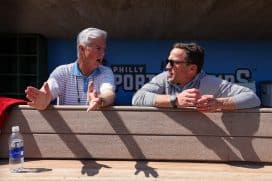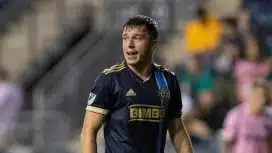Eagles
E60’s “Imperfect” Sheds Light on Issues Faced By Athletes Like Roy Halladay, Brandon Brooks
By Paul Bowman, Sports Talk Philly Editor
Last Friday night, ESPN released a mini-doc on Roy Halladay with E60’s “Imperfect”.
The show was excellent and should be watched by all Philadelphia sports fans and really those interested in sports in general.
If you haven’t seen it, Halladay’s family, mainly his wife, discusses many issues that Halladay himself dealt with, but were never really discussed in public.
The reasoning behind this: Roy felt as though he had to be perfect or else he would let everyone down and his life would be over. The need to keep any issues out of the spotlight, including major injuries, likely contributed to his tragic death in November 2017.
At it’s core, the story is meant to help alleviate the stigma around mental illnesses and the need for professional athletes to be superhuman.
Brandy Halladay says it herself: Roy never felt it was ok for him to be normal while he was playing baseball. He felt he needed to do whatever he had to do to make sure that no one knew of any of his struggles whether that involved pitching with an injured back for two seasons, taking prescription medication to keep pushing or leaving rehab before he could be properly treated because someone recognized him.
It is no secret that mental illnesses remain taboo in our culture and that players like Tom Brady, Mike Trout, Sidney Crosby and LeBron James are worshiped by their fans and the media as people who can do no wrong in the world, but players in every professional sport are human and subject to the same problems as everyone else. Their status as stars does not protect them from diseases, mental or physical, and their being affected by such a disease does not make them any less of a star.
That is the idea that “Imperfect” seeks to drive home.
Had Roy Halladay felt it was ok for him to experience back pain and seek assistance or had he felt it was ok or even brave of him to seek out assistance for his addiction to prescription drugs, there is a chance he could still be with us now.
The first effect to manifest itself, was extreme anxiety before each game. Anxiety that was so bad that caused him to not only avoid speaking to others all together, but to throw up and become sick before each start.
An injury that he didn’t share served to escalate the issues he was dealing with.
During the 2016 NFL season, Brandon Brooks missed two games because of illness – weeks 12 and 14 against the Packers and Redskins.
Each time he did not appear on the injury report and each time he was suddenly ruled out before the game.
Just a few days after his second absence, Brooks came forward and explained that he was suffering with anxiety and seeking help to cope with the problem.
Since then, he has found much support while speaking out about his issue, including as the commencement speaker for Miami (Ohio) in 2018.
Following that season, Brooks came back and made an even bigger impact on the team. In 2017, Brooks not only made his first Pro Bowl but made a significant impact on the Eagle securing their first Super Bowl Championship.
In the two seasons following that 2017 season, Brooks has suffered two major injuries, but missed just one playoff game in addition to the two games he sustained the injuries and one game in 2019 he missed with anxiety when his most ardent supporter, right tackle Lane Johnson, wasn’t available to start alongside him.
The three seasons that Brooks has played since addressing his anxiety issues have been better than the seasons before it and have solidly placed him in the conversation for one of the best free agent signings by the team all-time.
Looking at Roy Halladay and Brandon Brooks, the two players had the same root issue: the need to be perfect.
The difference between the two is that, while Halladay felt he would be ridiculed and deemed a failure if people knew of the anxiety and unhealthy focus he had on perfection, Brooks chose to take his demons public and seek help.
One decision early on affected how other resultant issues would compound or be avoided and it begs the question of how each player’s life could have been different.
For Brooks, there is a chance he would no longer be in Philadelphia were he still struggling alone. Offensive linemen often suffer a variety of what could be considered minor issues that can be played through (see Jason Kelce and Lane Johnson’s injuries following the 2018 season) but still need to be treated.
Like Halladay did with his back injury, Brooks could choose not to inform the team trainers of the injuries leading to more serious injuries and issues with the way he treated those “minor” injuries himself.
Maybe the Eagles don’t have a Super Bowl. Brooks may not have received his recent contract extension and may have needed to retire as his self-treated injuries piled up or did not heal correctly. He likely misses far more games and may not be the outgoing person he is on social media today.
Brooks’ interests outside football do not include flying but are more academic endeavors including politics, MBAs and foreign languages. If Brooks winds up sheltered as a result of his obsession with perfection, that knowledge is likely cut off and not put the the same use that it could be when he chooses to retire from the NFL.
For Halladay, he likely wouldn’t have gotten better like Brooks did (Brooks was entering his prime while Halladay was already there), but if he had felt comfortable going on what was then the disabled list and getting his back issues addressed right away, there’s the potential that he avoids and shoulder issues and is able to extend his career.
Of course, the obvious and most important change would be that Halladay could still be with us today. There’s no way to know for sure, but there is chance that Halladay is better able to cope with life after baseball and isn’t taken from the world tragically.
The Halladay family participated in the creation of the E60 documentary so that it could be used as a cautionary tale.
The goal is that more athletes will handle their problems in a healthy manner as Brandon Brooks has. The burden does not lay soley with these athletes, however.
Fans need to understand that athletes are human and suffer their own struggles. Top athletes are not perfect individuals and need to know that fans understand that.
For the hard city that it is portrayed to be in much of the media, Philadelphia has done a top-notch job of this with the support of players like Brooks and Nolan Patrick, who began suffering from migraines that were so bad he was sidelined before the season began. There is little to no animosity between fans and these players and plenty of understanding, understanding that lead to increased respect for Brooks upon his return to the lineup.
These are issues that many cities may be ill-equipped to deal with, but Philly is well on their way toward properly supporting their athletes, a situation that hopefully creates more stories that mirror that of Brooks than the tragic turn that Roy Halladay faced.












































